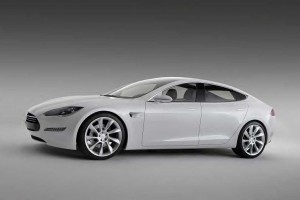
Silicon Valley start-up Tesla Motors promises to deliver a 7-seat family sedan with huge storage, 300-mile range and 45-minute charges by 2011.
Could the battery car finally be ready to replace the conventional, gasoline-powered automobile?
The Silicon Valley start-up, Tesla Motors, is betting its latest offering could come a lot closer to achieving that green-minded goal, by addressing some of the traditional shortfalls of the electric vehicle: limited range, long charging times, limited functionality, quirky styling and high cost.
Tesla CEO and Internet gazillionaire Elon Musk has revealed his battery-powered Holy Grail to a series of potential customers, and TheDetroitBureau.com has the inside story on the new Model S, which Musk suggests, “will likely be the world’s first, mass-produced, highway-capable EV.”
Whether Tesla can deliver is anything but certain. Despite the deep pockets of its founder, the company is struggling to come up with the money needed to build an assembly plant. It had to delay the launch of its Roadster due to nagging technical issues. And even an online news conference, intended to help launch the Model S, was crippled by technical problems. But that didn’t smother CEO Musk’s enthusiasm.
The S is being described as a seven-passenger family sedan capable of traveling up to 300 miles per charge. That would be about 50 percent more than the 200 mile range Tesla claims for its 2-seat Roadster, which it belatedly began delivering to customers, in limited numbers, late last year.
Even more significant – if Tesla can deliver – is its insistence that the Model S will be able to be fully recharged, using an onboard charging device, in as little as 45 minutes. That would, however, require a 480 Volt power supply which, in turn, would likely only be found in special community-based charging stations. The Model S would also be able to recharge – albeit more slowly – using 110 and 220 Volt power supplies.
Automotive engineers have been intrigued, for some time, by battery powertrain technology, because of a number of potential advantages. Electric motors generate maximum torque, for one thing, the moment they begin turning, which permits the Tesla Roadster to turn in sports car-like performance. Meanwhile, a battery-based drivetrain wouldn’t necessarily have to use the same layout required for an internal combustion engine.
And, it seems, Tesla plans to try a different vehicle architecture with Model S, mounting its powertrain under the floor, freeing up additional space for passengers and cargo. According to Musk, the vehicle would be able to swallow a 50-inch TV, a surfboard and a mountain bike simultaneously.
“Model S doesn’t compromise on performance, efficiency or utility — it’s truly the only car you need,” declares the Tesla CEO.
The start-up’s goal is to launch production of the Model S in 2011. But there’s a big “if”, in that Tesla doesn’t yet have a factory for it. That planned California facility apparently depends upon getting a requested $350 million loan from the U.S. Department of Energy’s Advanced Technology Vehicle Manufacturing Program. That program was designed to promote the development of “green” automotive vehicles.
The standard Model S, according to Musk, will deliver 0 to 60 times of “under six seconds and will have an electronically limited top speed of 130 mph, with sport versions expected to achieve 0-60 mph acceleration well below five seconds.”
The company isn’t offering much information about the electric drivetrain, except to note it will have a single-speed gearbox, apparently like the Roadster – which was originally designed to use a 2-speed transmission. It’s not clear whether there will be more than one motor, but it is expected that the sedan will rely on an advanced version of the Lithium-Ion, or LIon, batteries used by the Roadster. That design requires more than 6,000 individual cells arranged in packs, much like what’s used in laptop computers.
In a conversation with TheDetroitBureau.com, in January, Musk suggested that battery costs will begin coming down rapidly in the next few years, even as batteries become both smaller and more powerful.
Meanwhile, the sedan will offer a variety of high-tech systems, including a 17-inch touchscreen with in-car 3G connectivity allowing passengers to listen to Internet radio or consult Google Maps, even check their state of charge remotely from an iPhone or laptop.
The company intends to offer customers the choice of three battery packs, with ranges of 160, 230 or 300 miles per charge.
Tesla is shooting for a base price, for the Model S, of $49,900 — after a federal tax credit of $7,500. The company projects the cost of charging the Model S will come to around $5 for a 300-mile drive.
